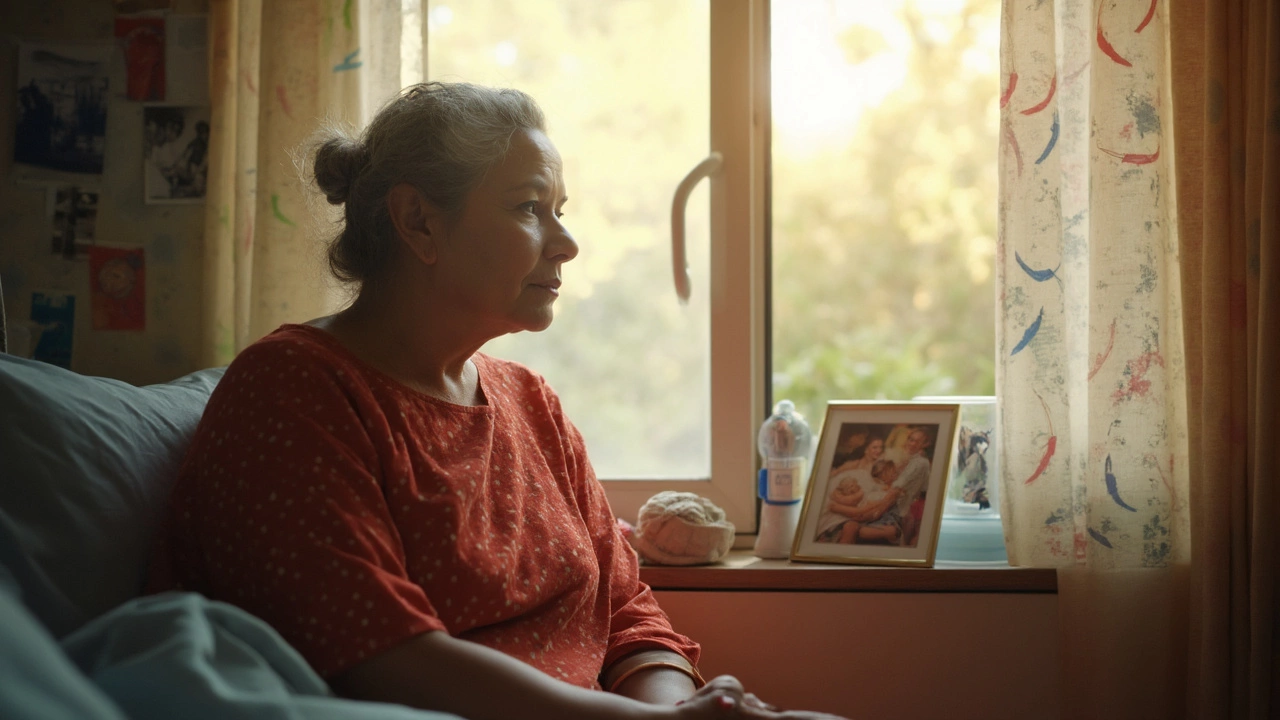Ask any doctor and they’ll tell you—the phrase “stage 4 lung cancer” tends to hit like a truck. You start searching for answers nobody wants to give. Can you actually live ten years with it? Or is that just wishful thinking?
Here’s the thing: while most people with stage 4 lung cancer don’t hit that ten-year mark, there are rare cases where folks have beaten the odds. It’s not common, but it’s not impossible anymore, either. And the number of long-term survivors has slowly ticked up over the last decade, thanks to a handful of treatment and lifestyle breakthroughs.
If you want real numbers, most oncologists used to toss out scary stats—like a 5% five-year survival rate. But those numbers are changing every year, thanks to better drugs and more personalized care. If you know exactly what kind of lung cancer you’re dealing with (small cell, non-small cell, which gene mutations, all that), doctors can sometimes throw everything at it—including immunotherapy, targeted pills, and new clinical trials.
I’ve seen someone in my own circle take their diagnosis as a slap from reality, but use it to squeeze more out of every day. He started to chase down every possible option, from specialist phone calls to homemade smoothies packed with veggies. Nobody can promise a decade, but there’s a lot more hope on the table—and way more ways to keep fighting.
- What Is Stage 4 Lung Cancer Anyway?
- How Long Can People Really Live?
- What’s Making Survival Better Than Before?
- Real-Life Tips and Stories for Living With Cancer
What Is Stage 4 Lung Cancer Anyway?
If you’ve just heard “stage 4 lung cancer,” you’re probably feeling like the bottom just dropped out. But let’s cut through the mystery and talk straight: stage 4 means the cancer has spread beyond the lungs. Maybe it’s in the other lung, the brain, bones, liver, or adrenal glands. Basically, it hopped on the express train and left the original station.
Doctors call this the “advanced stage.” It’s not about a size anymore. It’s about cancer cells setting up shop somewhere they shouldn’t. The technical word is metastasis. That’s why treatment strategies go way beyond just surgery—they might never even talk surgery at this point. Instead, they look at things like chemo, immunotherapy, or targeted pills, because the cancer’s not just in one spot anymore.
"When lung cancer reaches stage 4, it means it’s become a disease that affects the whole body, not just the lungs." — American Cancer Society
There are two main types: non-small cell lung cancer (about 85% of cases) and small cell lung cancer (about 15%). Why does that matter? The type changes what treatments may or may not work. Non-small cell tends to grow a bit slower, but both can get aggressive at stage 4. Genetic testing can flag certain mutations (like EGFR or ALK) that respond to cool new drugs.
Here’s a quick breakdown:
- Stage 4 means the cancer spread outside the chest or into fluid around the lungs or heart.
- It’s usually not “curable,” but treatable. The goal is control and more good days, not just survival time.
- Treatments are usually ongoing—think marathon, not sprint.
A recent study put together the most common places where lung cancer spreads:
| Where Cancer Spreads | Percent of Patients (at Stage 4) |
|---|---|
| Bones | 36% |
| Liver | 22% |
| Brain | 20% |
| Adrenal Glands | 15% |
This is why no two cases look the same. The exact places affected and the speed of spread—that’s where things get personal. If you’re reading this, or know someone fighting this thing, learning the nitty-gritty details is key. Every piece of info helps the doctor map out the best shot at giving you more time and better quality of life. If you ever hear a doctor talk about stage 4 lung cancer, it just means the cancer’s played its biggest card, but you’ve still got moves left.
How Long Can People Really Live?
Let’s get real about numbers first. Back in the day, most people diagnosed with stage 4 lung cancer were told their odds weren’t great. The five-year survival rate used to be buried well under 10%. The talk from oncologists was straight: the median survival was somewhere between 6 and 12 months.
Things have changed a bit. Not drastically, but enough that people are asking about longer horizons, even ten years. Today's five-year survival for all stage 4 lung cancers in big Western countries hovers around 7% to 10%. That sounds low, but these are averages, and averages can hide some surprising stories—especially if you’ve got one of the cancers with a targetable mutation, like ALK or EGFR.
Want to see how these numbers break down? Here’s a snapshot:
| Type | Median Survival (Months) | 5-year Survival Rate | 10-year Survival (Estimate) |
|---|---|---|---|
| All Stage 4 Non-Small Cell Lung Cancer | 8-13 | 7-10% | <2% |
| Stage 4 With EGFR/ALK Mutation | 18-36 | 15-30% | Up to 10% (very rare) |
| Small Cell Lung Cancer (Extensive Stage) | 6-12 | 2% | <1% |
Now for context: that "less than 2%" number for ten-year survival doesn’t mean zero. There are true outliers—real people who get the right combo of modern treatment, luck, and sheer stubbornness to make it a decade (or more). Though you won’t see that every day, it’s not a unicorn event either, especially if your cancer has a treatable mutation and you respond well to the new meds.
Let’s not sugarcoat it: stage 4 lung cancer is still one of the biggest mountains in cancer care. But now, doctors have a bigger bag of tricks. If you’re young, healthy, have a targetable mutation, and hit the right treatment, your shot at a longer life goes up. The ground is shifting, and longer-term survival with stage 4 lung cancer is showing up more and more in support groups and medical journals—even if it’s rare.

What’s Making Survival Better Than Before?
Lung cancer survival rates are finally seeing a slow but steady climb, and it’s not just luck. This shift is driven by real changes in how doctors find, diagnose, and treat the disease. Here’s what has actually changed the game lately:
- Targeted therapy: This one is a big deal for folks with stage 4 lung cancer. If your tumor has a certain genetic mutation (like EGFR, ALK, or ROS1), pills like osimertinib or crizotinib can home in on those exact switches and slow down the cancer in a way that older chemotherapy never could. People with these mutations often live significantly longer.
- Immunotherapy: Meds like pembrolizumab and nivolumab are helping the immune system see and attack cancer cells. They’ve given new hope to people who don’t respond to other treatments. Some are staying stable for years, which used to be unheard of for stage 4 lung cancer.
- Combined treatments: Docs are getting creative, mixing immunotherapy, targeted therapy, and classic chemo or radiation. Some lucky patients respond super well to these combinations.
- Better imaging and gene testing: These help catch cancer earlier and match the right treatment to the right person. You get less guesswork, more precision.
Treatments are getting smarter and less punishing. Side effects are much better managed than a decade ago, so people can stay on therapy longer. That adds up.
Here’s a quick look at how survival rates are trending for those who keep fighting:
| Year of Diagnosis | 5-Year Survival Rate (Stage 4 NSCLC) |
|---|---|
| 2000 | 1%-2% |
| 2010 | 4% |
| 2022 | 7%-10% |
So yes, the odds are better if you’re diagnosed today versus 20 years ago. None of this means survival is easy, but it’s proof that the outlook for people with advanced lung cancer is slowly changing for the better. It pays to ask your oncologist about clinical trials, new drugs, and genetic testing. This stuff is moving faster than you might think.
Real-Life Tips and Stories for Living With Cancer
Getting hit with a stage 4 lung cancer diagnosis doesn’t mean you bail on life. I’ve run into people who tossed out everything from old routines to old fears and got serious about making each day count. Their stories are a wild combo of honesty, hustle, and a ton of small wins stacked together.
One study from 2023 found that people with strong support systems—family, friends, or even a good online group—reported less pain and better mood, no matter how tough the treatments got. There are folks like Suresh from Pune, who lived past five years with stage 4, oddly proud of walking his dog every morning, just to prove he could. Or Rekha in Delhi, who logged every treatment and side effect in a notebook, turning her recovery into a science project she could actually control.
Here are a few real-life tips that can honestly shift things:
- Build a team: Don’t do this solo. Specialists, friends, even a no-nonsense nutritionist—people matter.
- Move your body daily: Even short walks or gentle yoga can keep your energy up and your head clear.
- Be picky about info: Don’t buy into miracle cures. Stick to treatments backed by your doctor and legit sources.
- Track your side effects: Write down every weird ache or rash. Your doctor can tweak meds faster if you’ve got details ready.
- Ask for help: If fatigue or pain gets bad, it’s not weak. Get family or friends to step up, or lean on a counselor.
If you’re looking for numbers to hang on to, check out this 2024 data:
| Years Since Diagnosis | % Still Living with Stage 4 Lung Cancer (US Data) |
|---|---|
| 1 year | 41% |
| 2 years | 20% |
| 5 years | 7% |
| 10 years | Less than 2% |
Meds like immunotherapy and targeted therapies (think Tagrisso, Keytruda) are behind those small but growing percentages. More hospitals are running support groups too, with folks who get what you’re dealing with in ways no doctor ever will. My friend Anjali was floored by how much one WhatsApp group could boost her mood after treatment days.
Bottom line—living ten years with stage 4 lung cancer is rare but not off the map. The fighters who last the longest tend to be stubborn, organized, and not afraid to lean on others. Maybe you’re that type. Maybe you’re not. But stealing back good days, one at a time, is still one of the strongest moves you’ve got.
